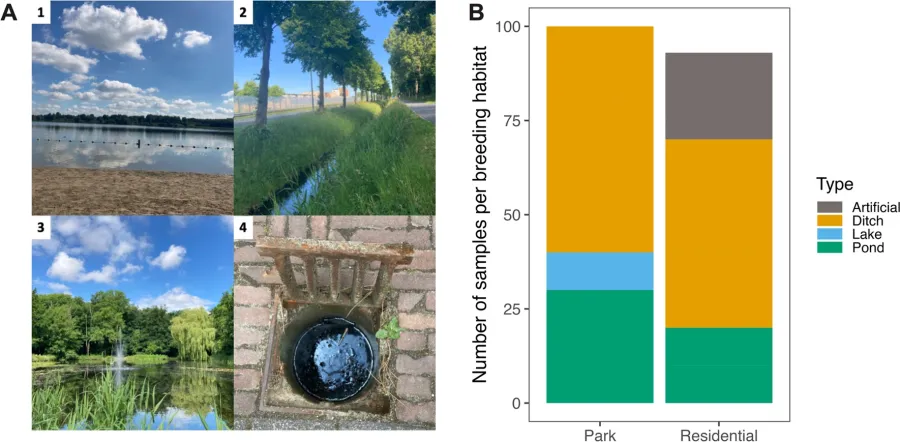Distribution of Culex pipiens life stages across urban green and grey spaces in Leiden, The Netherlands

This publication is part of the project ‘Preparing for vector-borne virus outbreaks in a changing world: a One Health Approach’ (NWA.1160.1S.210) which is (partly) financed by the Dutch Research Council (NWO).
Authors: Louie Krol, Melissa Langezaal, Lisa Budidarma, Daan Wassenaar, Emilie A. Didaskalou, Krijn Trimbos, Martha Dellar, Peter M. van Bodegom, Gertjan W. Geerling & Maarten Schrama
Background
In recent decades, the world has witnessed a remarkable increase in urbanisation, and it is estimated that in 2050 > 70% of the world’s population will live in sprawling urban areas [1]. Urbanisation and urban areas have been associated with increased mosquito abundance due to the loss of natural predators and the availability of suitable breeding habitats [2, 3]. This increase in mosquito abundance, coupled with a higher density of human population, has increased the occurrence of mosquito-borne diseases in urban areas, with suburban residential areas and areas in proximity to parks being particularly vulnerable [4,5,6]. Moreover, the temporal occurrence of these outbreaks can be linked to extreme weather events, such as heatwaves, drought and heavy erratic rainfall, which are projected to increase due to global climate change and which are generally more extreme in cities [7,8,9,10,11]. As cities continue to expand and climate change impacts become more pronounced, there is an urgent need to address the challenges posed by increasing mosquito-borne disease occurrences [7, 12].
One of the key strategies employed by cities to become more climate resilient are nature-based solutions, such as establishing green spaces, promoting biodiversity and integrating nature into the urban fabric [13,14,15]. For instance, cities are constructing green infrastructure, such as wetlands and city parks, and retrofitting buildings with green roofs, to absorb and manage stormwater and mitigate the urban heat island effect. Currently, there is a worry that (some of these) climate adaptation strategies will affect mosquito-borne disease risk, but it is unclear whether these are detrimental or beneficial for mosquitoes [7, 13, 16]. While the need for such solutions is clear, the challenge lies in implementing them while minimizing the risk of mosquito-borne diseases and mosquito-related nuisances [7, 17]. This necessitates a comprehensive understanding of the ecological factors driving mosquito distribution in urban areas. While some general patterns regarding the effects of vegetation and the availability of container breeding sites are known, there are almost no empirical data on mosquito distribution within urban environments—comparing green to grey spaces—or what role green and grey spaces in cities might play in mosquito population dynamics [18,19,20,21,22,23,24,25,26,27,28,29,30]. For this, we need to understand the distribution of the different life stages of mosquitoes, which is essential for establishing links with environmental factors, such as microclimate.
To understand how the various mosquito life stages are distributed across the urban fabric, we set out to investigate how these life stages (eggs, larvae, adults) are distributed across contrasting urban environments (city parks vs. residential areas) and how this covaries with the local microclimatic conditions. To this end, we investigated these factors in the metropolitan area of Leiden (NUTS-3 region), a typical Northwestern European urban area with a highly heterogeneous urban landscape consisting of densely populated residential areas interspersed with parks. In this study, we focused on Culex pipiens/torrentium(hereafter: Cx. pipiens), which is the most common and abundant mosquito (Culicidae) species in The Netherlands and Northwestern Europe [31,32,33]. This species is particularly abundant in urban areas, utilising a variety of habitats ranging from artificial containers to natural stagnant waterbodies for breeding [34,35,36,37]. Culex pipiens is also the primary vector for the transmission of both Usutu virus (USUV) and West Nile virus (WNV) [38,39,40,41].
Read the whole publication here.